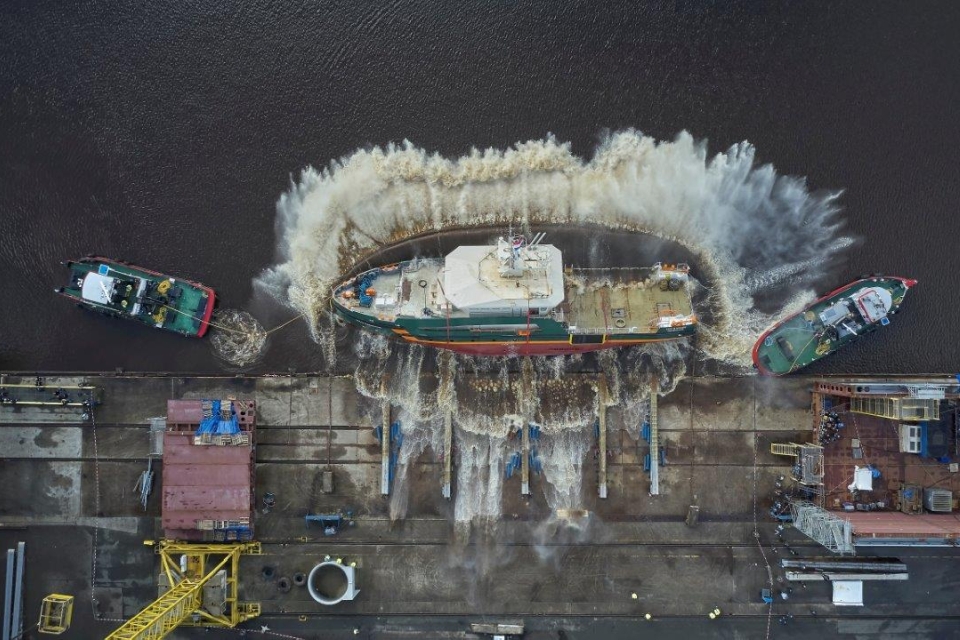Dutch yacht building and short sea are doing well, but all other categories of the Dutch maritime manufacturing industry are struggling. Trade association Netherlands Maritime Technology (NMT) draws this conclusion in its annual report 2023. Yet, there is a silver lining: the order books are on the rise.
The Dutch maritime manufacturing industry (shipyards, repair yards and suppliers) has had an eventful year with various developments and challenges on a European and global scale, states NMT.
An overview of how the different sectors did in 2022:
Inland shipping, fisheries and commercial vessels
The inland shipping sector had a tough time: Seventy ships were delivered in 2021, compared to forty in 2022. However, the order book is filled with 84 cargo ships (up from seventy in 2021). What stands out positively, and this includes the passenger ship and ferry segment, is the growing demand for sustainable transport and propulsion developments such as hydrogen, methanol and electricity. The ship repair industry showed good occupancy rates.
The fishing industry also faced challenges, including high gas oil prices and offshore wind farms where sailing is no longer allowed. Eighty vessels have now been registered for the decommissioning scheme set up by the Dutch government.
In the commercial vessel sector (workboats, tugs and pushers, patrol boats and small dredging equipment), things did not fare much better. With eighteen vessels delivered and eleven new orders in 2022, this niche is very lean.
Also read: NMT: Dutch companies should build new Rijksrederij fleet
Superyacht building
Dutch superyacht builders maintain their top position in the global market, mainly thanks to craftsmanship, innovation and high product quality. In 2022, 25 new orders were placed, bringing the total order book to 69 yachts with a total value of EUR 6.6bn.
Maritime suppliers
Maritime suppliers played a crucial role in the sector despite facing rising energy and procurement prices, European sanctions against Russia, project delays due to supply problems and a shortage of labour. Several electrical engineering, construction, components and services companies invested in technological innovations and sustainable solutions to strengthen the sector and cope with changing market conditions.
Total turnover in these niches rose 10.9 per cent to EUR 4.2bn in 2022 (EUR 3.8bn in 2021). Of this, about 57 per cent is generated by exports. The number of own employees rose from 17,812 in 2021 to 18,577 in 2022. The number of hired workers increased by more than 500 to 2,532. Major themes are and will continue to be sustainability and digitalisation.
Also read: European shipbuilding: Quo vadis? European Jones Act? A personal observation
Ocean-going ship newbuilding and short sea
The newbuilding sector of ocean-going ships had a mixed year, with a lower value of completed ships. In 2022, 31 ocean-going vessels were delivered (value: EUR 300m and significantly lower than 2021). In contrast, order intake increased by almost fifty per cent: 49 orders (value: EUR 600m).
The short sea sector (coastal shipping) continues to perform well, with an increase in order intake and a filled order book: 62 vessels. This highlights the growing need for efficient and sustainable short sea transport within Europe.
Ship repair
For the “repair & conversion” sector, 2022 was a positive year. Dutch shipyards deployed their expertise and capacity to carry out repair and maintenance work on ships from all over the world. Total turnover was EUR 425m (2021: EUR 343m), an increase of almost 25 per cent.
The number of major projects increased for the first time in years due to projects for the navy, conversion projects and projects in the cruise and yachting markets.
Also read: ‘There’s just ten years to go for shipbuilding in Europe’
Future
The Dutch shipbuilding industry remains committed to innovation, sustainability and craftsmanship. These are the elements that allow the sector to remain competitive. Despite the many serious challenges, there are plenty of opportunities to grow, both nationally and internationally.
There is a perception among NMT’s 451 members that threats to the European shipbuilding and supply industry have increased. The Netherlands has become increasingly dependent on China as a workshop and sales market, with China, South Korea and Japan being very formidable competitors. In twenty years’ time, more than half of the European market share of commercial marine vessels has left Europe for China.
To continue to exist and prosper, Dutch companies are seizing opportunities that can strengthen their position. Sustainability (and its speed) is one of the most important of these. The Maritime Master Plan is therefore fully committed to this: by investing in climate-neutral ships now, the Netherlands can bridge the gap between R&D and broad market scale-up and strengthen and expand its international competitive position in the four strategic end markets. These markets are: coastal and inland shipping, hydraulic engineering, offshore wind and maritime safety.
Also read: €2.3 million for Dutch Sustainable Shipbuilding Subsidy Scheme in 2023
Sector agenda
NMT sees an important role for the maritime manufacturing industry when it comes to solving societal challenges, including sustainable transport, rising sea levels, tapping into clean energy sources, producing (plant-based) food from the sea and safety.
This realisation has now also landed with the Dutch government. To cash in on the opportunities for the maritime manufacturing industry and face threats, the government and sector have joined forces. Those involved have started drawing up a sector agenda, which will be presented at the end of September. Marja van Bijsterveldt-Vliegenthart, mayor of Delft and former Minister of Education, has been appointed by Minister of Economic Affairs and the Environment Micky Adriaansen as envoy to guide this extensive process.
Also read: MIWB wins Horizon grant for major European shipbuilding project








